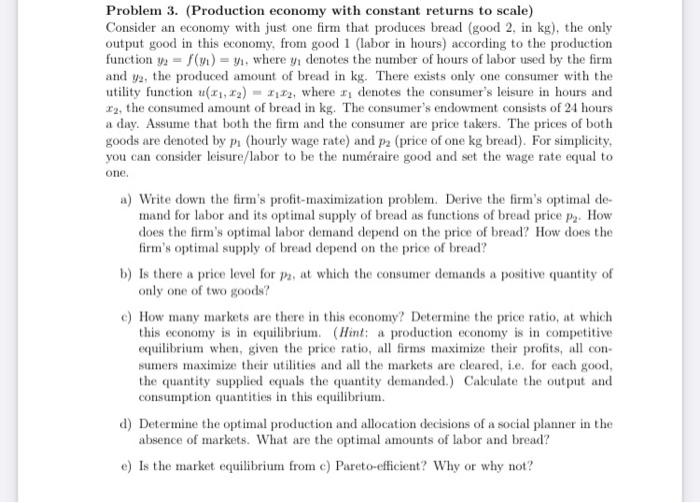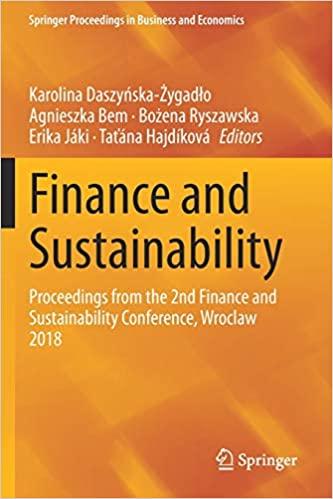Problem 3. (Production economy with constant returns to scale) Consider an economy with just one firm that produces bread (good 2. in kg), the only output good in this economy. from good 1 (labor in hours) according to the production function y = f(n)= y. where y, denotes the number of hours of labor used by the firm and y, the produced amount of bread in kg. There exists only one consumer with the utility function (12) - 1103, wherer denotes the consumer's leisure in hours and *2, the consumed amount of bread in kg. The consumer's endowment consists of 24 hours a day. Assume that both the firm and the consumer are price takers. The prices of both goods are denoted by pi (hourly wage rate) and p2 (price of one kg bread). For simplicity, you can consider leisure/labor to be the numraire good and set the wage rate equal to one. a) Write down the firm's profit-maximization problem. Derive the firm's optimal de mand for labor and its optimal supply of bread as functions of bread priceps. How does the firm's optimal labor demand depend on the price of bread? How does the firm's optimal supply of bread depend on the price of bread? b) Is there a price level for pa at which the consumer demands a positive quantity of only one of two goods? c) How many markets are there in this economy? Determine the price ratio, at which this economy is in equilibrium. (Hint: a production economy is in competitive equilibrium when, given the price ratio, all firms maximize their profits, all con- sumers maximize their utilities and all the markets are cleared i.e. for each good, the quantity supplied equals the quantity demanded.) Calculate the output and consumption quantities in this equilibrium. d) Determine the optimal production and allocation decisions of a social planner in the absence of markets. What are the optimal amounts of labor and bread? e) Is the market equilibrium from c) Pareto-efficient? Why or why not? Problem 3. (Production economy with constant returns to scale) Consider an economy with just one firm that produces bread (good 2. in kg), the only output good in this economy. from good 1 (labor in hours) according to the production function y = f(n)= y. where y, denotes the number of hours of labor used by the firm and y, the produced amount of bread in kg. There exists only one consumer with the utility function (12) - 1103, wherer denotes the consumer's leisure in hours and *2, the consumed amount of bread in kg. The consumer's endowment consists of 24 hours a day. Assume that both the firm and the consumer are price takers. The prices of both goods are denoted by pi (hourly wage rate) and p2 (price of one kg bread). For simplicity, you can consider leisure/labor to be the numraire good and set the wage rate equal to one. a) Write down the firm's profit-maximization problem. Derive the firm's optimal de mand for labor and its optimal supply of bread as functions of bread priceps. How does the firm's optimal labor demand depend on the price of bread? How does the firm's optimal supply of bread depend on the price of bread? b) Is there a price level for pa at which the consumer demands a positive quantity of only one of two goods? c) How many markets are there in this economy? Determine the price ratio, at which this economy is in equilibrium. (Hint: a production economy is in competitive equilibrium when, given the price ratio, all firms maximize their profits, all con- sumers maximize their utilities and all the markets are cleared i.e. for each good, the quantity supplied equals the quantity demanded.) Calculate the output and consumption quantities in this equilibrium. d) Determine the optimal production and allocation decisions of a social planner in the absence of markets. What are the optimal amounts of labor and bread? e) Is the market equilibrium from c) Pareto-efficient? Why or why not







